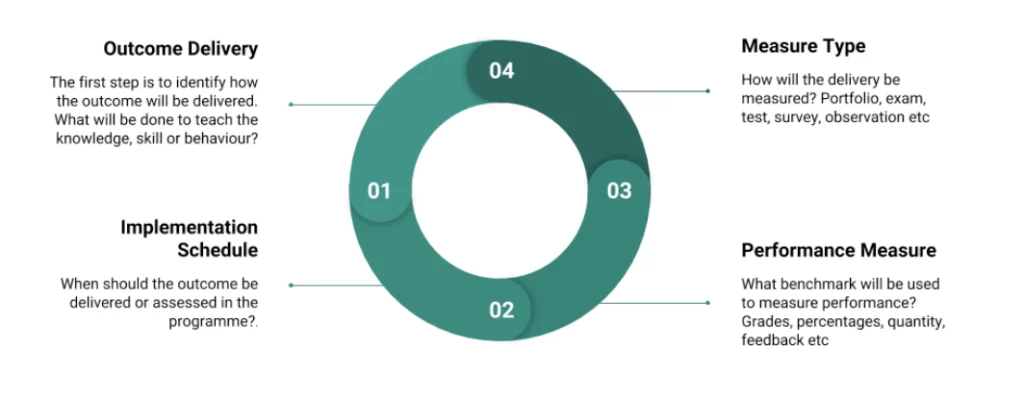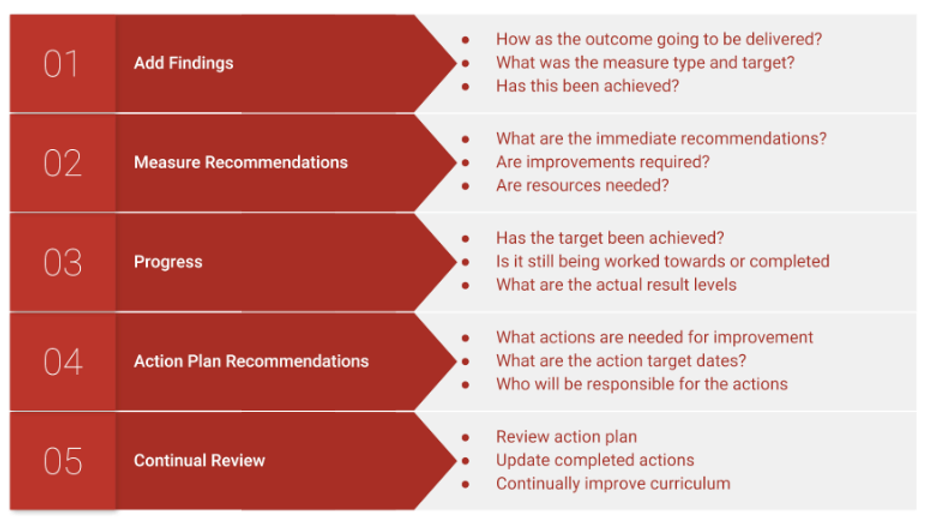After the publication of the new OfSTED Education Inspection Framework 2019, education and training providers will be aware of the new Quality of Education judgement. This judgement has been introduced to focus on the curriculum, which sets out what apprentices need to know and be able to do.
OfSTED’s definition of a curriculum is
The curriculum is a framework for setting out the aims of a programme of education, including the knowledge and skills to be gained at each stage (intent); for translating that framework over time into a structure and narrative, within an institutional context (implementation) and for evaluating what knowledge and skills learners have gained against expectations (impact/achievement).
The curriculum is made up of 3 distinct parts:
CURRICULUM INTENT
Education and training providers must be clear that curriculum intent is not a list of your curriculum aims published in a document or website.
Curriculum intent is:
a framework for setting out the aims of a programme of education, including the knowledge and understanding gained at each stage
A framework of aims is very different from a bullet point list of aims
Essentially, the intent is to determine what you want learners to do and why.
When considering a curriculum intent framework, education and training providers need to ensure the following:
- Your apprenticeship curriculum sets out how knowledge, skills and behaviours needed to take learners to the next stage of education, training, or employment will be developed.
- You can demonstrate clearly what learners need to be able to know and do at the end of their learning or training programme.
- You have planned and sequenced the curriculum so learners can build on previous teaching and learning and develop the new knowledge and skills they need.
- Your curriculum offers learners the knowledge and skills that reflect the needs of the local and regional context.
- Your curriculum intent considers the needs of learners, employers, and the local, regional and national economy, as necessary.
- Your curriculum ensures all learners benefit from high academic, technical and vocational ambitions.
- Your curriculum is ambitious for disadvantaged learners or those with SEND, including those with high needs, and should meet those needs.
CURRICULUM IMPLEMENTATION
the translation of that framework over time into a structure and narrative, within an institutional context
The next stage in the Quality of Education judgement is considering how education and training providers demonstrate their implementation. Like curriculum intent, this cannot be covered by a statement in a document or posted to a website.
Inspectors will use various methods to judge curriculum implementation; a statement will not be sufficient.
Inspectors will want to see the following:
- The curriculum that learners follow
- Intended endpoints towards which those learners are working
- How well are learners progressing through the curriculum
- Reviews of curriculum plans or other long-term planning
- Observations of classes, workshops and other activities
- Learner work
- View of learners
- How staff record, upload and review data
- Content and pedagogical content knowledge
When considering a curriculum implementation, education and training providers need to ensure the following:
- Your staff have expert knowledge of the subjects that they teach. If they do not, they are supported to address gaps so that learners are not disadvantaged by ineffective teaching.
- Your staff enables learners to understand key concepts, present information clearly, and promote discussion.
- Your staff check learners’ understanding effectively and identifies and corrects misunderstandings.
- Your staff ensure learners embed key concepts in their long-term memory and apply them fluently and consistently.
- Your staff have designed and delivered the subject curriculum in a way that allows learners to transfer key knowledge to long-term memory.
- The curriculum is sequenced so that new knowledge and skills build on what learners know and can do, and learners can work towards defined endpoints.
- Your staff uses assessment to check learners’ understanding and inform teaching.
- Your staff uses assessment to help learners embed and use knowledge fluently, develop their understanding, and gain, extend, and improve their skills, not memorise disconnected facts.
CURRICULUM IMPACT
the evaluation of what knowledge and skills learners have gained against expectations
Finally, education and training providers will need to address curriculum impact and be clear that the whole purpose of the Quality of Education judgement is for inspectors to focus more on the curriculum and less on the generation, analysis and interpretation of performance data. Inspectors will be interested in the conclusions drawn and actions taken from internal assessment information but will not examine or verify that information first-hand.
To make their judgement, inspectors will look at the following:
- Learner attainment
- Evidence of learner progress
- Destination data
- Conversations about what they have remembered, the knowledge and skills they have acquired, and how their learning enables them to connect ideas.
When considering curriculum implementation, education and training providers need to ensure the following:
- Your staff has developed a well-constructed, well-taught curriculum that leads to good results and reflects what learners have learned.
- Your staff ensure that disadvantaged learners and learners with SEND acquire the knowledge and skills they need to succeed.
- Your staff ensure that end-point assessments and examinations of learners’ work can demonstrate what knowledge, skills, and behaviours have been developed.
- Your curriculum ensures that all learning builds towards an endpoint.
- Through your curriculum, all learners are being prepared for their next stage of education, training or employment at each stage of their learning.
DEVELOPING AN APPRENTICESHIP STANDARD PROGRAMME
Providers must consider their curriculum intent, implementation, and impact when developing an apprenticeship programme (standards).
As well as the detailed questions set out in the sections above, there are general questions that should be asked throughout the curriculum design process:
- What is going to be taught, how will it be taught, and how will it be sequenced throughout the apprenticeship
- How are learners going to acquire the necessary knowledge, skills and behaviours?
- How will learners be supported in their progression and provided with knowledge and skills to benefit them?
- What elements of the programme give learners transferable skills and knowledge?
- How will the apprentice’s existing skills and knowledge be built on?
IDENTIFYING WHAT APPRENTICES NEED TO KNOW AND CAN DO
The first step in designing the curriculum plan is identifying the apprenticeship standard’s knowledge, skills, and behaviours. These standards set out the endpoints that learners will be working towards. However, when designing the curriculum, the intent, implementation and impact cannot be done in isolation. Providers must first determine the performance measures for each outcome to demonstrate impact. This should be a four-step process: state what will be delivered or what the apprentices will need to do, identify the measure type that will be used, define the performance benchmark, and finally, schedule when the outcome will be implemented or completed.

For each knowledge, skill, or behaviour in the apprenticeship standard, providers should be able to show what they are delivering to develop the KSB and how they will determine whether the learners have absorbed and retained what has been taught.
What types of measures can providers use?
There is a wide range of performance measures that providers can use, such as:
- Grades achieved by learners on assessed work
- Observations
- Surveys
- Exams
- Interviews
- Products or work
- Portfolio submissions
CURRICULUM SEQUENCE
Once education and training providers have identified the outcomes, what will be delivered, and how learning will be assessed, the curriculum sequence will be created. Inspectors will make a judgement on this:
how carefully leaders have thought about the sequence of teaching knowledge and skills to build on what learners already know and can do.
Like curriculum intent statements, the curriculum sequence cannot just be a vague timetable added to a document or web page.
There needs to be detailed about what is being delivered, when it is being delivered, and why it is being delivered. Inspectors will check how “leaders have ensured that a subject curriculum includes content that has been identified as most useful and that this content is taught in a logical progression, systematically and explicitly for all learners to acquire the intended knowledge, skills and behaviours.”
There must be detail – What is the activity? What will apprentices learn? How does it build on previous learning? Is the learning in a logical order? Which outcomes or endpoints are being covered? What learning material will be used? What assessment is planned?
DEVELOPING CURRICULUM MATERIAL
Inspectors will also focus on how the curriculum is taught at the subject, classroom, or workshop level. They will want to see teaching examples and expect examples of teaching materials, such as PowerPoint, e-learning, assessments, and workbooks.
The development of learning and teaching material is key to successful delivery. It must be relevant to the curriculum activity and the intended learning outcomes. The quality of the material has to meet learner expectations. If staff cannot create a suitable PowerPoint presentation, then there is a clear indicator that additional CPD might be needed. How well do learners enjoy lessons or workshops? Do you get learner reviews at the end of a session? Do you perform observations of teaching, learning, and assessment? How do we make sure that staff have the skills to deliver workshops?
Providers also need to review eLearning quality and, in some cases, introduce it to their programmes. What sort of eLearning system do you use? Is content Scorm or Tin Can? How can you track learning and progress? Do you need a Learning Record Store to dive deeper into apprenticeship learning and activities? Can it be used on mobile devices? Have you considered gamification to encourage learner engagement? How do you give feedback to learners? How does staff feedback support learner development? What do you use to award grades to learners?
THINKING ABOUT CURRICULUM IMPACT
When inspectors evaluate the impact of the education provided to learners, they will focus on what learners have learned and the skills they have gained and can apply.
If the curriculum intent planning has been done correctly, then the delivery staff will already have identified the outcomes (endpoints) that need to be achieved and the performance measures that will be used to determine success.
To measure the curriculum’s impact, staff must review performance cyclically, usually annually.
Where apprenticeship providers run rolling programmes, they must determine a suitable cut-off point for their reviews.
The review process should follow the format:

The review of the performance measures has to have a purpose in the improvement of the curriculum. Each performance measure must be worked through, and staff must add their findings and recommendations.
Where findings need improvement, the reviewers should add this to a programme action plan. The action plan is key to improving the curriculum and overall delivery.
Conclusion
In conclusion, the new OfSTED Education Inspection Framework 2019 places a significant emphasis on the quality of education, with a particular focus on the curriculum. This framework underscores the need for education and training providers to meticulously consider their apprenticeship curricula’ intent, implementation, and impact.
The intent of the curriculum must be clear and comprehensive, establishing the aims and objectives of the educational programme. It should not merely be a list of aims but a well-thought-out framework detailing what learners need to know and the skills they need to acquire at each stage of their learning. This involves planning and sequencing the curriculum to build on previous knowledge and skills, addressing the needs of learners, employers, and the broader economic context.
Implementation requires translating the curriculum framework into a structured and coherent narrative within the institutional context. This involves ensuring teaching staff have the expertise and support to deliver the curriculum effectively. The curriculum should enable learners to understand key concepts, apply their knowledge fluently, and build towards defined endpoints. Effective assessment methods should be employed to check learners’ understanding and inform teaching practices.
Impact focuses on evaluating the knowledge and skills learners have gained against expectations. Inspectors will look for evidence of learner progress, attainment, and the application of acquired knowledge and skills. The curriculum should be well-constructed and well-taught, leading to good results and preparing learners for their next stage of education, training, or employment. It is essential that the curriculum also addresses the needs of disadvantaged learners and those with special educational needs and disabilities (SEND), ensuring they acquire the necessary knowledge and skills to succeed.
In developing an apprenticeship programme, providers must continually address these aspects—intent, implementation, and impact—throughout the curriculum design process. They must determine what will be taught, how it will be taught, and how it will be sequenced. This includes identifying the knowledge, skills, and behaviours apprentices need to acquire, developing appropriate teaching and learning materials, and implementing robust assessment and review processes.
Adhering to these principles allows education and training providers to ensure that their apprenticeship programmes are effective, comprehensive, and aligned with the needs of learners and the wider economy. This holistic approach enhances the quality of education and equips apprentices with the skills and knowledge they need to succeed in their careers.



